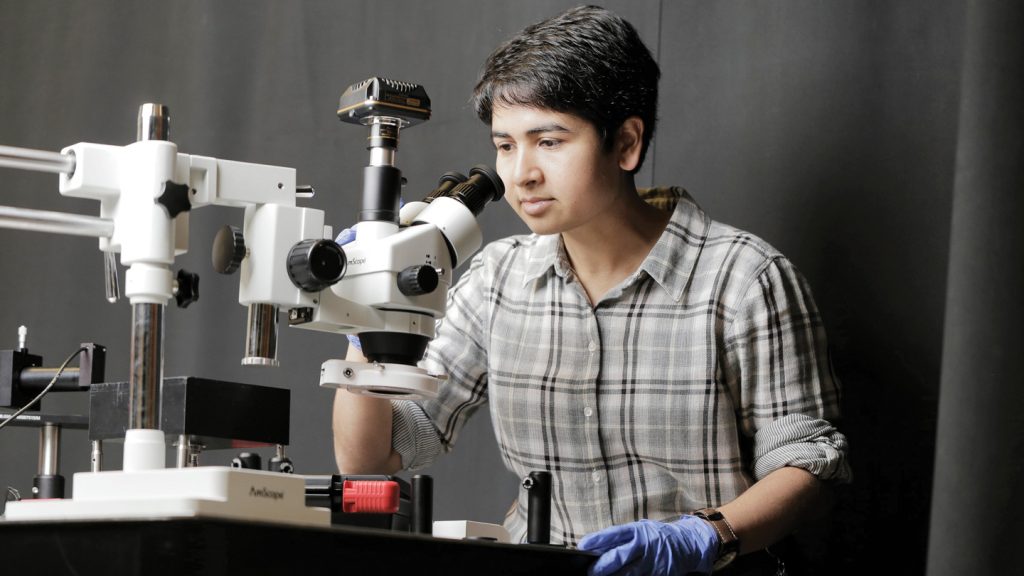Deblina Sarkar is building microscopic machines to enter our brains

Deblina Sarkar makes little machines, for which she has big dreams. The machines are so little, in fact, that they can humbly inhabit living cells. And her dreams are so big, they may one day save your mind.
Sarkar is a nanotechnologist and assistant professor at MIT. She develops ultratiny electronic devices, some smaller than a mote of dust, that she hopes will one day enter the brain. She’s also a fan of Kung Fu movies and likes to dance her own twist on bharata natya, a classical Indian dance form. Occasionally she goes hiking with her graduate students, once taking them as far as Yellowstone. Building camaraderie is vital, Sarkar says. But “I’m probably working day and night on my research,” she confesses. “There is an urgent problem at hand.”
That problem is Alzheimer’s disease, Parkinson’s disease and other neurological afflictions that assault the minds of millions of people worldwide. Sarkar’s solution: Employ minute machines to detect and reverse these disorders.
“She was always interested in applying … electronics to biological systems,” says collaborator and bioengineering researcher Samir Mitragotri of Harvard University, who has known Sarkar for about a decade and was on her thesis committee. She envisions using her tools to “transform how people are conducting biology,” he says, “bridging the worlds.”
A focus on nanoelectronics
Born in Kolkata, India, Sarkar credits both of her parents as early inspirations. Her boldness as a researcher comes from her mother, who as a young woman defied social norms in her village by working to fund her own education and speaking out against the dowry system. Meanwhile, Sarkar’s father sparked her fascination for engineering.
At the age of 15, he abandoned his dreams of becoming an engineer to find other jobs; he needed to support his parents and the rest of his family after his father, an Indian freedom fighter, was shot in the leg and could no longer work. Still, Sarkar recalls her father finding time for his passion, fashioning devices to make home life more convenient. These included an electricity-free washing machine and vehicles that could freight hefty loads down local byroads to their house.
“That got me very, very interested in science and technology,” Sarkar says. “Engineering specifically.”
After earning a bachelor’s degree in electrical engineering from the Indian Institute of Technology Dhanbad, Sarkar moved to California to study nanoelectronics at the University of California, Santa Barbara. There, she tested new ways to create nanodevices that could reduce the amount of power consumed by computers and other everyday electronics.
One standout device Sarkar developed during her graduate work was a transistor that reduced the amount of power lost as heat by 90 percent compared with some of today’s most common silicon transistors (SN: 3/18/22). For the breakthrough, UC Santa Barbara awarded Sarkar’s Ph.D. dissertation the Lancaster Award for its impact in advancing math, physical sciences and engineering.
When tech meets the body
Along the way, Sarkar became fascinated with the brain, which she calls “the lowest energy computer.” A project imaging amyloid-beta plaques as a postdoc at MIT opened the door to fusing her dual interests, and she stayed on as an assistant professor to found the Nano-Cybernetic Biotrek group. Her group develops nanodevices that can interface with living cells, and “neuromorphic” computing devices, which have architectures inspired by the human brain and nervous system.
So far, the group’s most innovative device may be the Cell Rover, a flat antenna that could monitor processes inside cells. For a study reported in 2022, Sarkar and her colleagues used magnetic fields to finesse a Cell Rover, roughly the size of a tardigrade, into a mature frog egg cell. The team demonstrated that when stimulated by a magnetic field created by an alternating current, molecules in the nanodevice vibrated at frequencies safe for living cells. Using a wire coil receiver, the researchers were able to detect how those vibrations affected the device’s own magnetic field, thus showing it could communicate with the outside world. Cell Rovers could be outfitted with films that latch onto and detect select proteins or other biomolecules.
Sarkar envisions using the device to spot misfolded proteins in the brain that may be early signs of Alzheimer’s disease. Today, memory loss is the only way to know a living person has Alzheimer’s, but by then, the damage is irreversible, Sarkar says. Cell Rovers could also be paired with nanodevices that harvest energy from and electrically stimulate cells, opening the door for new types of brain electrodes and subcellular pacemakers. Or fleets of remotely controlled devices could replace invasive surgeries — detecting a small tumor growing in the brain, for example, and maybe even killing it.
She’s essentially establishing a new field of science, at the intersection of nanoelectronics and biology, Mitragotri says. “There are many opportunities for the future.”
One day, Sarkar hopes to insert nanodevices between human neurons to boost the computing speed of the fleshy processor already in our skulls. Our brains are remarkable, she says, but “we could be better than what we are.”